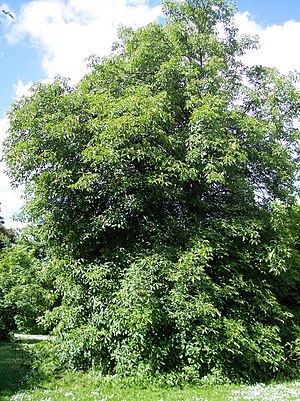What is a Buckeye - Buckeye Tree
Ohio State University football team is called Buckeyes. What is a Buckeye? The Ohio buckeye is the state tree of Ohio. The buckeye tree is Aesculus glabra Willdenow. It is a small tree with a short trunk and narrowish crown usually reaching a height of about 50 feet, but very old individuals may be taller.
The Ohio Buckeye is most easily recognized by its palmately compound leaves (with 5-7 leaflets arranged as fingers on a hand) and clusters of small, pale yellow flowers that occur at the ends of branches in late April to early May. In native settings, it is usually found along river banks. It occurs throughout Ohio, which is near the eastern edge of its range, but it ranges west through Indiana, Illinois, southeastern Iowa and Missouri to eastern Arkansas, Oklahoma, and Texas.
Today the Buckeye is not widely used by man except occasionally as a cultivated landscape plant and sometimes for its seeds, which are carried as good luck charms. In the past, when large Buckeye trees were more plentiful in the forests, they were considered valuable timber trees. The wood, which is white, fine-grained, and moderately soft, was widely used for turning and for making small items of woodenware, such as bowls, spoons, handles, ornaments and boxes. Because it is easy to carve and resists splitting, it was once an important material for the manufacture of artificial limbs, and it was used for flooring, the bodies of wooden vehicles, and for inexpensive furniture. The bark produces a yellow dye that has been used to tan leather, and the seeds were used as a source of oil for lamps, an insecticide, and bookbinder's paste.
The Ohio Buckeye is most easily recognized by its palmately compound leaves (with 5-7 leaflets arranged as fingers on a hand) and clusters of small, pale yellow flowers that occur at the ends of branches in late April to early May. In native settings, it is usually found along river banks. It occurs throughout Ohio, which is near the eastern edge of its range, but it ranges west through Indiana, Illinois, southeastern Iowa and Missouri to eastern Arkansas, Oklahoma, and Texas.
Today the Buckeye is not widely used by man except occasionally as a cultivated landscape plant and sometimes for its seeds, which are carried as good luck charms. In the past, when large Buckeye trees were more plentiful in the forests, they were considered valuable timber trees. The wood, which is white, fine-grained, and moderately soft, was widely used for turning and for making small items of woodenware, such as bowls, spoons, handles, ornaments and boxes. Because it is easy to carve and resists splitting, it was once an important material for the manufacture of artificial limbs, and it was used for flooring, the bodies of wooden vehicles, and for inexpensive furniture. The bark produces a yellow dye that has been used to tan leather, and the seeds were used as a source of oil for lamps, an insecticide, and bookbinder's paste.

![Reblog this post [with Zemanta]](http://img.zemanta.com/reblog_e.png?x-id=64e3db50-3dfa-41c5-9704-e687244870af)

0 comments:
Post a Comment